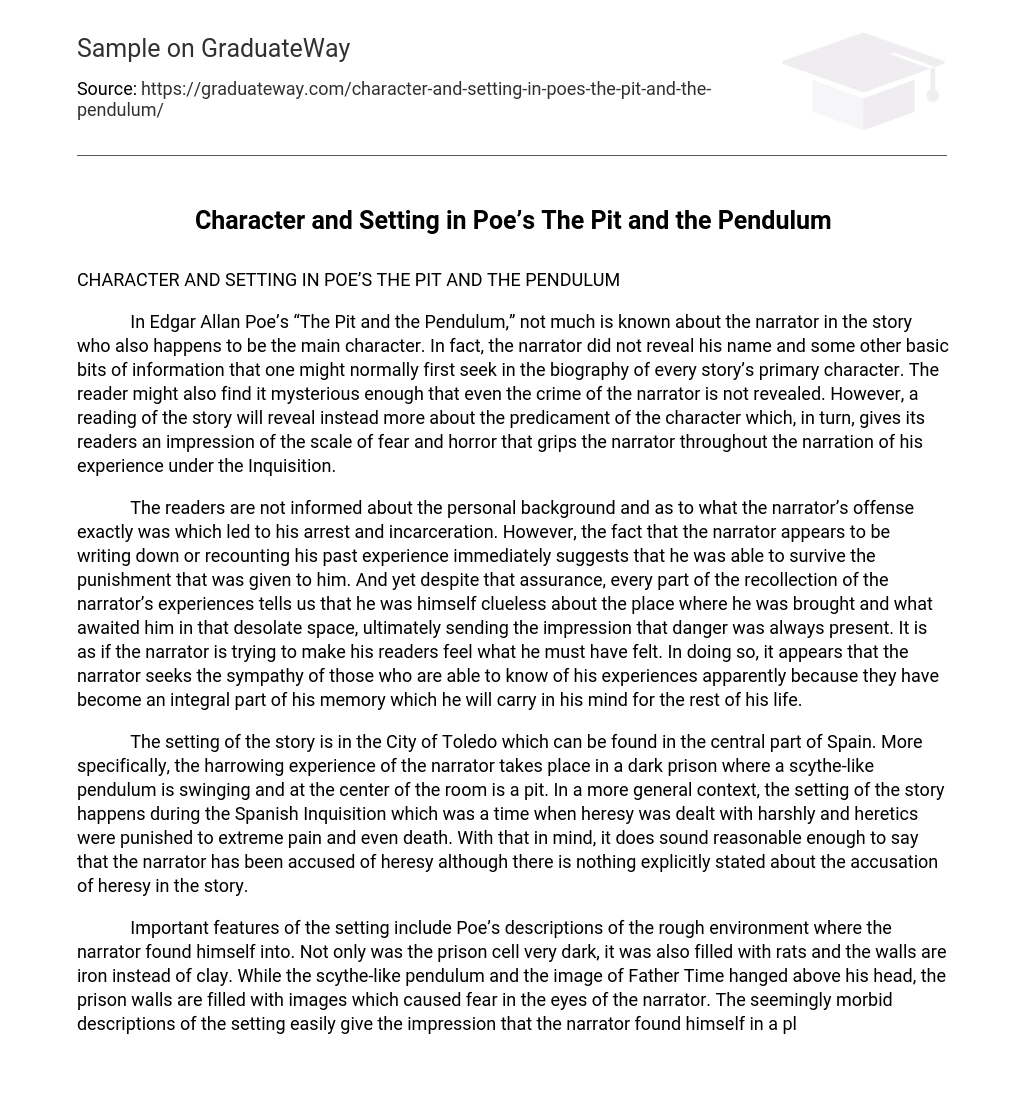In Edgar Allan Poe’s “The Pit and the Pendulum,” not much is known about the narrator in the story who also happens to be the main character. In fact, the narrator did not reveal his name and some other basic bits of information that one might normally first seek in the biography of every story’s primary character. The reader might also find it mysterious enough that even the crime of the narrator is not revealed. However, a reading of the story will reveal instead more about the predicament of the character which, in turn, gives its readers an impression of the scale of fear and horror that grips the narrator throughout the narration of his experience under the Inquisition.
The readers are not informed about the personal background and as to what the narrator’s offense exactly was which led to his arrest and incarceration. However, the fact that the narrator appears to be writing down or recounting his past experience immediately suggests that he was able to survive the punishment that was given to him. And yet despite that assurance, every part of the recollection of the narrator’s experiences tells us that he was himself clueless about the place where he was brought and what awaited him in that desolate space, ultimately sending the impression that danger was always present. It is as if the narrator is trying to make his readers feel what he must have felt. In doing so, it appears that the narrator seeks the sympathy of those who are able to know of his experiences apparently because they have become an integral part of his memory which he will carry in his mind for the rest of his life.
The setting of the story is in the City of Toledo which can be found in the central part of Spain. More specifically, the harrowing experience of the narrator takes place in a dark prison where a scythe-like pendulum is swinging and at the center of the room is a pit. In a more general context, the setting of the story happens during the Spanish Inquisition which was a time when heresy was dealt with harshly and heretics were punished to extreme pain and even death. With that in mind, it does sound reasonable enough to say that the narrator has been accused of heresy although there is nothing explicitly stated about the accusation of heresy in the story.
Important features of the setting include Poe’s descriptions of the rough environment where the narrator found himself into. Not only was the prison cell very dark, it was also filled with rats and the walls are iron instead of clay. While the scythe-like pendulum and the image of Father Time hanged above his head, the prison walls are filled with images which caused fear in the eyes of the narrator. The seemingly morbid descriptions of the setting easily give the impression that the narrator found himself in a place where death was just within arm’s reach and where the light of hope shining down is almost next to impossible.
The combination of the setting and the responses of the narrator towards the descriptions of his environment provide the primary reason why Poe’s story effectively incites fear unto the reader as if the story is real. Apparently, there are certain parts of the story which seem at first to reflect certain real world objects and events such as the Spanish Inquisition although it should be remembered that the story itself is fiction.
Poe describes in the detail the predicament of the narrator especially the part where the hot iron wall and the swinging pendulum almost ended the life of the narrator. His descriptions and his use of literary devices give the readers the feeling as if they were near the setting of the story and that their lives, too, can become endangered. It is as if the combination of the descriptions of the setting, the main character and his predicament amplify the cause of fear upon reading the story.
Reference
- Poe, E. A. (2008). The Pit and the Pendulum: Quill Pen Classics.





